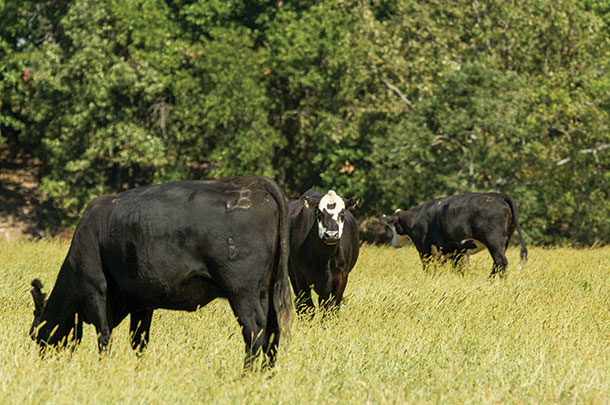The late Bud Williams had a quote something along these lines: “Ranchers love their cows and hate their grass. They need to learn to love their grass and hate their cows.” Hate is a strong word, and if a highly influential voice on low-stress stockmanship is telling you to “hate” cattle, you should know it’s hyperbole. But it takes strong language to make strong points at times, and the point is worth making. In the long run, the ranch’s value does not come from the cattle on it. The ranch’s real value comes from its ability to grow forage.
Carrying capacity (the number of animal units the ranch can support) is dynamic. It is constantly changing based on moisture, growing conditions and management. When it comes to moisture and growing conditions, we are dealt our hand of cards by nature and by past land-use decisions. We ought to be able to control our own management, sure. But increasing the carrying capacity of land is a long-term effort, especially in brittle, lower-rainfall environments. In the short term, unless we invest in stock water and fence development, we have the carrying capacity we have.
Stocking rate, on the other hand, is entirely under our control. Whereas carrying capacity is the number of animal units the ranch can support, stocking rate is the number of animal units we ask the ranch to support. And because carrying capacity is dynamic, stocking rate has to be dynamic too. It should change from year to year and seasonally within a year.
Flexible grazing units
For much of the country, a system in which fewer cow units are maintained on the ranch allows for stockpiling of forage, extending the grazing season and moving away from a hay-dependent system. When done well, this can dramatically reduce the cost of carrying cows over the winter months.
Alternatively or additionally, it’s possible to adjust stocking rate of the ranch so the ranch is more heavily stocked at some portions of the year than others. This allows more forage to be harvested closer to its peak nutritive value in the growing season. Animal units that are grazed for only a portion of the year are sometimes called “flexible grazing units” or flex grazers. Typically, flexible grazing units are growing classes of cattle (e.g., stockers, developing heifers or even grass-finishers).
It is easy to see why growing cattle are flexible: If the projected value of gain is not large enough to justify the continued investment of forage they will require, we get those animal units off the ranch. In business terms, we would say we projected too poor of a gross margin to continue that investment.
What about breeding stock?
Growing cattle are not the only flexible animal units on the ranch. A similar thought process really ought to apply to breeding females as well. Cows are still flexible animal units we can choose to own or not own. Cows are less flexible units at most times of the year, sure. We may or may not need to wean their calves off them, calve them out or rebreed them prior to sale. Stage of production at the time of marketing will affect cow value.
But this means we have a greater responsibility to be proactive rather than reactive, monitoring weather and growing conditions and making projections about females’ value if they are carried to the next production time point. For example, is the projected difference in value between a bred cow and an open cow large enough to justify the continued investment in carrying her on the ranch for a number of months? Is that the most profitable opportunity to invest those dollars and that forage?
Breeding females are not permanent installations on the ranch, but we are prone to think of them that way. Because of this, we often hear discussion about “culling criteria” for cattle with respect to age, performance, structure, pregnancy status, etc. All of these criteria need to be considered when females are considered for marketing. But if all we are doing is “culling” problematic females, we probably are missing some opportunities to be proactive marketers of cattle before they become problematic, low-value animals.
Cows are costly
Mature cows are our lowest-maintenance animals in terms of the quality of diet they require and their resiliency to moderate swings in body condition. That make a non-lactating cow a nice class of animal to carry over the winter. But cows are also our highest-maintenance animals in terms of the quantity of diet they require relative to the pounds of product they produce. If we take a big-picture perspective, feeding 1,200-pound cows all year long in order to generate 600-pound weaned calves to sell is an inherently inefficient conversion energetically. And that would be a better-case scenario than most. Most cows are weighing far more and weaning calves well under 50% of their bodyweight – an even more inefficient conversion.
With this perspective, cows are a “necessary evil” in the calf-producing process, as odd as that may sound. In addition, cows are also going down in value, potentially rapidly depending on their age. We should actively be trying to get cows off the ranch if they are not efficient at converting their annual cost into weaned calf value. Off-loading those cows before seasons of lower forage growth helps to bring down the stocking rate on the ranch, let alone make the herd more productive.
Proactive marketing
What most often happens in droughts? Often, the forage is grazed into the ground until the ranch is forced to sell cows, usually at a low market value. What most often happens in cow culling decisions? All of the value is depreciated out of the cow until the ranch has little choice but to sell her because of age, structural problems or failure to become pregnant. By strategically marketing animals, we can avoid overgrazing and preserve the ranch’s forage-producing ability.
By strategically marketing later-conceiving, lower-productivity cows before they become low-value cows, we can capture more of the value of those animals rather than depreciating them out fully. The problems and solutions are tied together, and they mostly have to do with our mindset.
There is no magic ratio of cow units to growing cattle, but a system in which growing classes of cattle make up a proportion of the animal units on the ranch has tremendous advantages for the flexibility of how heavily the ranch is stocked. A similar goal can be accomplished by custom-grazing cattle for another operation when forage allows. Likewise, even if flexible grazers will not be brought onto the ranch, decreasing stocking rate seasonally to extend the grazing season is almost always a worthwhile goal to reduce cow carrying costs.
You can’t free up forage for any of these goals without first marketing lower-productivity cows, however. You don’t have to hate them; you just have to hate spending a dollar without a return.








